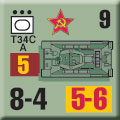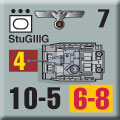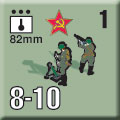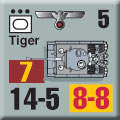| Kursk: Burning Tigers
Scenario Preview, Part Five
By Mike Bennighof, Ph.D.
May 2023
 It’s long been my goal to see the Panzer Grenadier series cover the entire sweep of World War II. And we’ve done that, with battles set in every continent except one (North America). But at the center of all of that has to lie history’s greatest tank battle, the clash of armor at Kursk in July 1943. It’s long been my goal to see the Panzer Grenadier series cover the entire sweep of World War II. And we’ve done that, with battles set in every continent except one (North America). But at the center of all of that has to lie history’s greatest tank battle, the clash of armor at Kursk in July 1943.
How one measures the “greatness” of a tank battle can vary (if one can indeed call any event that involves the mass slaughter of humans “great”). But until the Battle of Kursk, the German high command still at least believed they could take the operational initiative on the Eastern Front. Afterwards, they would be on the defensive until Lt. Rakhimzhan Qoshqarbaev raised the red banner over the German Reichstag n Berlin.
That makes this battle worthy of study: the last time the Germans thought they could win a battlefield victory against the Soviets. It’s also a story of bravery and sacrifice, and one in which evil reels away in defeat. Let’s have a look at one of the more intense chapters in Kursk: Burning Tigers, as the fateful assault on Ponyri Station begins.
Chapter Five
Ponyri Station
 On the left the German Ninth Army’s attack, the XLI Panzer Corps would attack directly southward with two infantry divisions at the front and a single panzer division in reserve behind them to exploit the expected breakthrough. Like the other infantry divisions in the first wave, they would be substantially reinforced with heavy tanks, assault guns and additional combat engineers. On the left the German Ninth Army’s attack, the XLI Panzer Corps would attack directly southward with two infantry divisions at the front and a single panzer division in reserve behind them to exploit the expected breakthrough. Like the other infantry divisions in the first wave, they would be substantially reinforced with heavy tanks, assault guns and additional combat engineers.
Just beyond the first line of Soviet defenses lay a railroad station called Ponyri. Descriptions from the time call it “seedy” and rather run down. But it lay directly in the path of the proposed German advance, and it would have to be captured before Walter Model and his army could meet even their first set of objetives.
Within days, survivors on both sides would be comparing Ponyri Station to Stalingrad.
Scenario Twenty
Ferdinand Attacks
5 July 1943
 Reinforced with huge “Ferdinand” tank destroyers, the 292nd Infantry Division’s first-day objectives called for the quick seizure of Aleksandrovka before wheeling to the left to take Ponyri Station in conjunction with the 86th Infantry Division. Once the initial Soviet defenses had been breached and the towns behind them secured, the waiting 18th Panzer Division would burst through the opening. At least that was the plan. Reinforced with huge “Ferdinand” tank destroyers, the 292nd Infantry Division’s first-day objectives called for the quick seizure of Aleksandrovka before wheeling to the left to take Ponyri Station in conjunction with the 86th Infantry Division. Once the initial Soviet defenses had been breached and the towns behind them secured, the waiting 18th Panzer Division would burst through the opening. At least that was the plan.
Conclusion
The Germans spearheaded their attack with a detachment of massive “Ferdinand” tank destroyers, later re-named the “Elefant.” These huge machines boasted 200mm of frontal armor and a long-barreled 88mm gun, making them absolutely deadly against enemy tanks. On the other hand, they had no machine guns for self-defense against enemy infantry, and no cupola for the commander to spot enemy infantry. And with their slow speed, they could barely waddle away from enemy infantry.
That made them a prime target for enemy infantry. Soviet soldiers, rigorously prepared for these German attacks, allowed the Ferdinands to roll over or past their foxholes, then emerged to wreak havoc on the supporting infantry. Time and again they forced the gigantic machines to turn back and fight over ground their commanders considered already won while tank killer squads eliminated the tank destroyers, often by firing flamethrowers into the air intake vents. Despite heavy losses the Germans did take Aleksandrovka, but the cost signaled that this would beno easy breakthrough.
Notes
The Germans are on the attack against a well-fortified Soviet position held by a middle-of-the-road rifle division supplied with abundant heavy weapons. But the Germans have the Elefant tank destroyer, and their cute little Goliath exploding toy tanks, something you’d expect a costumed super-villain called “The Toymaker” to deploy. The Elefants aren’t really all that useful here: the Soviets have no armor so it’s going to be up to the German infantry to dig the RKKA out of their entrenchments.
Scenario Twenty-One
Steel Avalanche
5 July 1943
 While part of the 292nd Infantry Division attempted to drive the Soviet defenders out of Aleksandrovka, most of the division attacked on the left flank to support the drive on Ponyri Station. Though already battered, the Soviet 15th Rifle Division held firm on the ridges west of Ponyri. The division’s recon units had brought in a German prisoner the night before with detailed knowledge of the coming attack. Despite the warning, they still had to face what one officer called a “steel avalanche” of oncoming armored vehicles. While part of the 292nd Infantry Division attempted to drive the Soviet defenders out of Aleksandrovka, most of the division attacked on the left flank to support the drive on Ponyri Station. Though already battered, the Soviet 15th Rifle Division held firm on the ridges west of Ponyri. The division’s recon units had brought in a German prisoner the night before with detailed knowledge of the coming attack. Despite the warning, they still had to face what one officer called a “steel avalanche” of oncoming armored vehicles.
Conclusion
“Soviet soldiers heroically struggled with the attacking groups of enemy,” went a Soviet account. “The infantry skillfully destroyed his tanks with grenades and bottles filled with mixtures of fuel.” When night fell the Soviet infantry still held the ridge lines, with the aid of reinforcements and strong artillery support.
Notes
This is a much bigger scenario than the last, but follows a similar outline: a German infantry assault, this time backed by a pretty strong armored contingent, against a well-fortified Soviet line with copious heavy weapons at hand. This time the fortifications are even thicker and protected by a huge number of minefields, so the German is going to have to keep moving and make good use of his assault guns in combined-arms assaults.
Scenario Twenty-Two
Storm Panzers
5 July 1943
 The 86th Infantry Division would lead XLI Panzer Corps’ attack on Ponyri Station, with the actual panzers (18th Panzer Division) to follow through the breach made in the Soviet lines. The German Ninth Army staff knew that the Soviets had prepared deep defenses against their attack, and reinforced the infantry division with 45 Storm Panzers (known to Allied intelligence, but not the Germans, as the Brummbär or “Grouch”) of the 216th Heavy Panzer Detachment in addition to the majority of the 90 Ferdinands of the 653rd and 654th Antitank Detachments. The Soviets had some new heavy metal of their own awaiting them. The 86th Infantry Division would lead XLI Panzer Corps’ attack on Ponyri Station, with the actual panzers (18th Panzer Division) to follow through the breach made in the Soviet lines. The German Ninth Army staff knew that the Soviets had prepared deep defenses against their attack, and reinforced the infantry division with 45 Storm Panzers (known to Allied intelligence, but not the Germans, as the Brummbär or “Grouch”) of the 216th Heavy Panzer Detachment in addition to the majority of the 90 Ferdinands of the 653rd and 654th Antitank Detachments. The Soviets had some new heavy metal of their own awaiting them.
Conclusion
The Soviet defenders fought off four waves of German attackers, but the fifth assault finally achieved a penetration. Reinforcements in the form of a tank brigade stabilized the situation and held the line long enough for an anti-tank brigade to arrive and secure the Soviet lines. The Germans would not take the tumbledown railroad station without a fight.
Notes
Resistible force meets immovable object. The German assault group is huge, with lots of Elefant tank destroyers, Storm Panzer heavy assault guns and just plain assault guns to back them up. But the defending force is even huger, with all the entrenchments, minefields and heavy anti-tank guns they could want plus some armor support of their own. This could be a long day for the Herrenvolk.
Scenario Twenty-Three
Holding Ponyri
6 July 1943
 The Soviet 307th Rifle Division had initially held the second line of the Soviet defenses in front of Ponyri Station, but the destruction of 81st Rifle Division exposed Maj. Gen. Mikhail A. Enshin’s men to the full fury of the German assault. Raised in Ivanovo north-east of Moscow in August 1941, the division had escaped encirclement at Bryansk, fought in front of the Soviet capital and helped crush the Hungarians at Voronezh. The veteran division would not retreat again. The Soviet 307th Rifle Division had initially held the second line of the Soviet defenses in front of Ponyri Station, but the destruction of 81st Rifle Division exposed Maj. Gen. Mikhail A. Enshin’s men to the full fury of the German assault. Raised in Ivanovo north-east of Moscow in August 1941, the division had escaped encirclement at Bryansk, fought in front of the Soviet capital and helped crush the Hungarians at Voronezh. The veteran division would not retreat again.
Conclusion
“The selflessness of the soldiers and officers, their perseverance and steadfastness in battle,” Enshin write, “ensured the success of the second day of the battle. The Nazis were stopped.” Enshin’s division suffered terrible losses, but dealt out even more punishment to the attacks. Though the Soviet yielded some ground, they had held their line.
Notes
This is an unusual scenario, with the German player selecting a flanking attack force that may or may not arrive on the battlefield (it probably will, but it’s mathematically possible for it to never arrive). It’s a mechanic very similar to that of a Napoleonic game the local wargame group used to play a lot, but as far as I can recall the first time something like this has been done in Panzer Grenadier’s 3,000-whatever scenarios. That Perryman, he knows scenario design.
And that’s all for Chapter Five. Next time, we charge into Chapter Six.
You can order Burning Tigers (Playbook edition) right here.
Please allow an extra three weeks for delivery.
Sign up for our newsletter right here. Your info will never be sold or transferred; we'll just use it to update you on new games and new offers.
Mike Bennighof is president of Avalanche Press and holds a doctorate in history from Emory University. A Fulbright Scholar and NASA Journalist in Space finalist, he has published a great many books, games and articles on historical subjects; people are saying that some of them are actually good.
He lives in Birmingham, Alabama with his wife, three children, and new puppy. He misses his lizard-hunting Iron Dog, Leopold.
Want to keep Daily Content free of third-party ads? You can send us some love (and cash) through this link right here.
|
